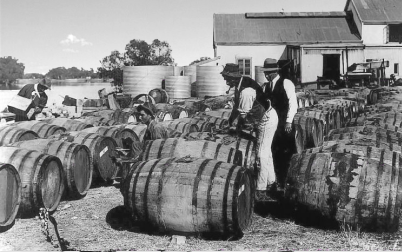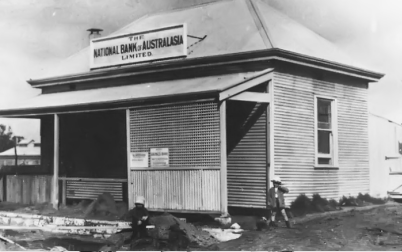|
1918
Starting from 1918, I have collected the Murray Pioneer Articles relating to the Winery. Here are the extracts :-
April 12th 1918
Berri Distillery. Towards the close of last year the question of what was to be done with doradillos was mooted at the B.C.P.U., and the government was approached with a view to erecting a distilling plant in Berri, to save growers the expense of carting to Renmark.
Mr. G.E. Lane, inspector of buildings for the Irrigation Dept. selected an ideal site, just outside the western boundary of the present settlement; when the whole scheme of linking up Berri and Cobdogla into one irrigation area is completed, the distillery will be as central as possible.
The building is at the top of a gentle rise, on the left of the Cobdogla road, and tanks, walls and floors are made of re-inforced concrete. The contractor, Mr. A.P. Lennon, a returned soldier, has had considerable experience in the erection of wine cellars and distilleries, having built the cellars and distillery at Nuriootpa, also champagne and fermenting cellars at Magill (Penfold & Co.). Besides work in other states and in California. He is the inventor of Lennon's granolithic patent pavement and slagetto. Mr. Warner, who is associated with him, has also been engaged in work of this kind before.
When complete, besides the still, two crushers and a press-the mobile patent manufactured in South Australia by Chas. Whitehill & Co.- which will extract the juice from the grapes so thoroughly that the husks will almost burn. The 33 tanks will have a total capacity of 88,000 gallons, so that with two fillings a season, as estimated, something like 10,000 tons of grapes can be put through. By adding twenty 4,000 gallon storage tanks, this quantity could be doubled as the still would easily cope with it. The still, designed by Mr. Englebrecht, and constructed by Whitehill & Co., is of the continuous type, and has a capacity of up to 7,000 gallons an hour.
Each load of grapes that is brought in will be unloaded into the crusher, from which the juice will be pumped into 24 fermenting tanks above ground, each to hold 2,800 gallons. Any liquid still adhering to the grape husks will be eliminated by the mobile press. Should the husks be pressed after fermentation, instead of before, a labour-saving device, in the shape of a conveyor belt, will be fixed to carry the husks from the tank to the press. The liquid will remain in these tanks to ferment for 6 or 5 days, gravitating thence into subterranean tanks, from which it will be pumped into the still. The liquid that distills over will be practically pure, or absolute alcohol, 160 proof, and be used either for motive power or for fortifying wines etc.
An important by-product, tartaric acid, will also be made, this at £40 a ton, is worth saving. The first year's operations will be confined to grapes, but probably, later on, other fruits will also be accepted for distillation. This season, for growers' convenience, crushers were put in by Mr. Penfold-Hyland in the town-ship, but it is confidently expected that the new plant will be ready long before next season's vintage.
 
|
My comments on the above article :- I have to define what was built in 1918 for the 1919 vintage. No.3 Ferment Cellar is still intact as of October 2002. The "Old Continuous" still source is explained. I have to research the Whitehill Company records! The capacity of the still was 7,000 gallons per day, not per hour. The grape receiving tanks are as follows-after my visit in November 2002. Count the sugarloaf tanks as they were 4,500 gallons capacity. I believe we made them pairs in the 1960's. It would have been Leslie Penfold-Hyland that coordinated the 1918 vintage on the Berri riverbank.
|
 
|
National Bank of Australia premises in Vaughan Terrace opening reported in the edition of Friday 20 September 1918 . Page 256 on microfilm.
|
Bill Wilden said he had seen a Pioneer article reporting that the Minister for Lands and/or Irrigation had warned that if Doradillo grapes were planted a distillery would have to be built.
1921
October 21th 1921, page 370
BCPU shareholders held a meeting on Saturday 15th October 1921 at the Berri Institute and decided to separate from the Distillery and would seek Government approval.
November 18th 1921, page 466
Minister for Irrigation Mr. T. Pascoe called for tenders for reinforced concrete works at the Berri Distillery.
December 2nd 1921, page 516
A meeting in the evening at the Berri Institute on Saturday 26th November 1921 which was chaired by Mr. Vivian Cock, District Officer, elected Messrs R. Curren and J.C. Cheriton of the BCPU, W.M Gillard of the Old Settlement, H. Berriman and J.L. Minnis of Lone Gum, Mr. L. Brugeaud of Marshall and H.E Trott of Glossop to be the provisional committee which negotiate with the BCPU who are the present lessees of the Distillery.
December 23rd 1921 page 588
At the Berri Institute in the evening of Saturday December 20th 1921 a meeting considered the proposed Articles of Association for the new Cooperative. Mr. R. Curren was chairman and using rules the Renmark, Waikerie and Berri Distilleries with some slight textual alterations, the rules were agreed to.
1922
February 3rd 1922 page 87
On January 30th 1922 the draft constitution was passed by the Provisional Committee and submitted to the Government, who then asked for further information as to likely capital costs.
February 10th 1922 page 113
Monash and Lone Gum vines are coming into production and the distillery will be handling quantities of Doradillos and Gordos.
February 24th 1922 page 159
At Glossop Post office Mr. L. J. Mander went to collect his post. His horse decided to go home and was seen arriving by Mr L.C. Tucker and a search was started for Mr. Mander. The horse with cart safely negotiated many narrow channel bridges on the way home. Eventualy Mr. Mander was found safely at home.
March 17th 1922 page 230
The Berri Distilley
Extensive Additions Being Made
NEW MANAGER APPOINTED
Berri March 13th 1922
The extension of the Berri Irrigation Area, as a result of soldier settlement, coupled with the fact that a number of the planted blocks are this year coming into bearing for the first time, has necessitated extension of the storage and plant of the Berri Distillery, which at present is quite inadequate to deal with the increased quantity of grapes that will soon be coming in for distilling purposes. The necessity for an increase of storage provision has long been fore-seen, but the current increased outputs from the blocks has made the question and urgent one. When the alterations now in hand have been completed the growers of Berri will be in possession of a first class distillery with a production plant and storage ample for all probable demands of the district. The work of extension, which is chiefly of reinforced concrete, has been let by contract to Mr W. Pascoe, of Berri, under the supervision of the building inspector of the Irrigation Department. Mr. Pascoe is an expert in this form on construction. His connecton with the Trussed Concrete Steel Co. Ltd., in England and America, one of the largest firms in this line of work in the world, enabled him to gain an experience of its practical adaptability for all types of building construction. To a visitor to the distillery, it is obvious that the job has only reached the early stages. Near the present building extensive excavations have been made for the sites of bond store, storage and fermenting tanks. The work in hand consists of a new spirit and bond store, covering an area of 70 feet x 45 feet. This building is to have walls 24 feet high, with large gabled roof, and is to have two floors. On the lower floor twenty or more spirit tanks will be placed on small stillage walls built for that purpose. The upper floor, which is supported from the wall piers on eight concrete columns is to be of jarrah timbers on 18 inch by 6 inch bearers, and 9 inch by 3 inch posts. There is also to be a loading platform built out on to the roadway between the bond store and the distillery. The other additions consist of new landing bins for the grape mills, 24 fermenting tanks, eighteen large storage tanks with semi-circular roof of concrete, four underground tanks with concrete roof and five large leaching tanks. Practically the whole of the tanks, with the exception of those devoted to storage purposes, will be covered with a large overhanging galvanised roof. A large number of men are employed under Mr. N. Dyer, the foreman.
Mr. O.A. von Dippe has resigned his position of manager of the distillery, as he he finds his work in connection with the Rivoli Theatre, of which he is joint lessee with Mr. O.E. Kunoth, occupies the greater portion of his time. The new manager is Mr. J. Rump, who was for 24 years with Seppelt's and has had a wide experience in the business.
Mr. Max Ranger(need to check) page 230, delivered the first load of grapes to the distillery for this season on Wednesday, March 8th. The load consisted of about a ton and a half of Pedros, which gave a fair average test. It is stated that this season is expected to be more favourable than last for distillery grapes, the percentage of sugar being delivered being believed to be generally higher.
July 28th 1922 page 65
Meeting called for share subcriptions.
R. James, Acting Secretary.
July 28th 1922 page 65
A meeting was called for share subscription for the Berri Cooperative Distillery Ltd. R. James, Acting Secretary.
November 17th 1922 page 450
November 14th
Eric Paynter was appointed Secretary after having 6 months clerical experience at the BCPU. Plays violin, football and a keen rower.
Eric Paynter was appointed.
1923
March 9th 1923 page 233
Cost per acre for development over 3 years was £93 pounds.
April 13th 1923 page 352
Monash, Glossop and Winkie will come into production for the 1924 vintage. Plant can handle 150-200 tons per day. Largest day to date in 1923 is 155 tons. Additions are now being made.
May 25th 1923 page 497
Last load on Tuesday 22nd May 1923.
In 5 years time the intake will be fourfold.
Dec 21st 1923 page 585
Dec 18th, Berri
Mick Butcher, died of heart attack on last Friday morning.
3 sons, 3 daughters. Eldest Esma, then Gladys and Adelaide. Sons were Laurie, Eric and Charles.
Eldest son Laurie, mate on the paddle steamer JG Arnold missed funeral.
Mick was a contractor, horticulturist and owner of the s.s. Ventura.
|

